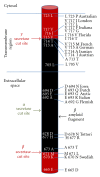The genetics of Alzheimer's disease
- PMID: 24278680
- PMCID: PMC3820554
- DOI: 10.6064/2012/246210
The genetics of Alzheimer's disease
Abstract
Alzheimer's disease is a progressive, neurodegenerative disease that represents a growing global health crisis. Two major forms of the disease exist: early onset (familial) and late onset (sporadic). Early onset Alzheimer's is rare, accounting for less than 5% of disease burden. It is inherited in Mendelian dominant fashion and is caused by mutations in three genes (APP, PSEN1, and PSEN2). Late onset Alzheimer's is common among individuals over 65 years of age. Heritability of this form of the disease is high (79%), but the etiology is driven by a combination of genetic and environmental factors. A large number of genes have been implicated in the development of late onset Alzheimer's. Examples that have been confirmed by multiple studies include ABCA7, APOE, BIN1, CD2AP, CD33, CLU, CR1, EPHA1, MS4A4A/MS4A4E/MS4A6E, PICALM, and SORL1. Despite tremendous progress over the past three decades, roughly half of the heritability for the late onset of the disease remains unidentified. Finding the remaining genetic factors that contribute to the development of late onset Alzheimer's disease holds the potential to provide novel targets for treatment and prevention, leading to the development of effective strategies to combat this devastating disease.
Figures

References
-
- Selkoe DJ. Biochemistry and molecular biology of amyloid β-protein and the mechanism of Alzheimer’s disease. Handbook of Clinical Neurology. 2008;89:245–260. - PubMed
-
- Selkoe DJ. Alzheimer’s disease: a central role for amyloid. Journal of Neuropathology and Experimental Neurology. 1994;53(5):438–447. - PubMed
-
- Braak H, Braak E. Evolution of neuronal changes in the course of alzheimer’s disease. Journal of Neural Transmission. 1998;(53):127–140. - PubMed
-
- Beyreuther K, Dyrks T, Hilbich C, et al. Amyloid precursor protein (APP) and beta A4 amyloid in Alzheimer’s disease and Down syndrome. Progress in clinical and biological research. 1992;379:159–182. - PubMed
Publication types
LinkOut - more resources
Full Text Sources
Other Literature Sources
Research Materials
Miscellaneous

